The newest Raspberry Pi 400 almost-all-in-one computer is very, very slick. Fitting in the size of a small portable keyboard, it’s got a Pi 4 processor of the 20% speedier 1.8 GHz variety, 4 GB of RAM, wireless, Ethernet, dual HDMI outputs, and even a 40-pin Raspberry Standard IDE-cable style header on the back. For $70 retail, it’s basically a steal, if it’s the kind of thing you’re looking for because it has $55 dollars worth of Raspberry Pi 4 inside.
In some sense, it’s getting dangerously close to fulfilling the Raspberry Pi Dream. (And it’s got one more trick up it’s sleeve in the form of a huge chunk of aluminum heat-sinked to the CPU that makes us think “overclocking”.)
We remember the founding dream of the Raspberry Pi as if it were just about a decade ago: to build a computer cheap enough that it would be within everyone’s reach, so that every school kid could have one, bringing us into a world of global computer literacy. That’s a damn big goal, and while they succeeded on the first count early on, putting together a $35 single-board computer, the gigantic second part of that master plan is still a work in progress. As ubiquitous as the Raspberry Pi is in our circles, it’s still got a ways to go with the general population.

The Raspberry Pi Model B wasn’t, and isn’t, exactly something that you’d show to my father-in-law without him asking incredulously “That’s a computer?!”. It was a green PCB, and you had to rig up your own beefy 5 V power supply, figure out some kind of enclosure, scrounge up a keyboard and mouse, add in a monitor, and only then did you have a computer. We’ve asked the question a couple of times, can the newest Raspberry Pi 4B be used as a daily-driver desktop, and answered that in the affirmative, certainly in terms of it having adequate performance.
But powerful doesn’t necessarily mean accessible. If you want to build your own cyberdeck, put together an arcade box, screw a computer into the underside of your workbench, or stack together Pi Hats and mount the whole thing on your autonomous vehicle testbed, the Raspberry Pi is just the ticket. But that’s the computer for the Hackaday crowd, not the computer for everybody. It’s just a little bit too involved.
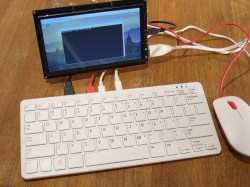 The Raspberry Pi 400, in contrast, is a sleek piece of design. Sure, you still need a power supply, monitor, and mouse, but it’s a lot more of a stand-alone computer than the Pi Model B. It’s made of high-quality plastic, with a decent keyboard. It’s small, it’s light, and frankly, it’s sexy. It’s the kind of thing that would pass the father-in-law test, and we’d suggest that might go a long way toward actually realizing the dream of cheaply available universal (open source) computing. In some sense, it’s the least Hackaday Raspberry Pi. But that’s not saying that you might not want one to slip into your toolbag.
The Raspberry Pi 400, in contrast, is a sleek piece of design. Sure, you still need a power supply, monitor, and mouse, but it’s a lot more of a stand-alone computer than the Pi Model B. It’s made of high-quality plastic, with a decent keyboard. It’s small, it’s light, and frankly, it’s sexy. It’s the kind of thing that would pass the father-in-law test, and we’d suggest that might go a long way toward actually realizing the dream of cheaply available universal (open source) computing. In some sense, it’s the least Hackaday Raspberry Pi. But that’s not saying that you might not want one to slip into your toolbag.
Teardown
 You can’t send Hackaday a piece of gear without us taking it apart. Foolishly, I started by pulling up the sticker, thinking I felt a hidden screw head. Nope, injection molding mark. Then, I pulled off the rubber feet. More molding marks. (Kudos for hiding them so nicely!) Save yourself the trouble; all you have to do to get the Pi 400 open is to pry gently around the edge, releasing each little plastic clip one after the next. It only takes five minutes, and as it says in the motorcycle repair manuals, installation is the reverse of removal.
You can’t send Hackaday a piece of gear without us taking it apart. Foolishly, I started by pulling up the sticker, thinking I felt a hidden screw head. Nope, injection molding mark. Then, I pulled off the rubber feet. More molding marks. (Kudos for hiding them so nicely!) Save yourself the trouble; all you have to do to get the Pi 400 open is to pry gently around the edge, releasing each little plastic clip one after the next. It only takes five minutes, and as it says in the motorcycle repair manuals, installation is the reverse of removal.
Inside, there’s a flat-flex that connects the keyboard, and you see that big aluminum heat sink. It’s almost the full size of the keyboard, and it’s thick and heat-taped to the CPU. You know it means business. It’s also right up against the aluminum bottom of the keyboard, suggesting it could get radiative help that way, and maybe keep your fingers warm in the winter. (I didn’t feel any actual heat, but it’s gotta go somewhere, right? There are also vents in the underside of the case.)
Four PZ1 screws and a little bit of courage to unstick the pad get you underneath the heat spreader to find, surprise!, a Raspberry Pi 4. This was a little anticlimactic, as I’ve just spent a couple weeks looking over the schematics for my review of the new Compute Module 4, and it’s just exactly what you’d expect. It’s a Raspberry Pi 4, with all the ports broken out, inside a nice keyboard, with a beefy heat spreader. Ethernet magnetics sit on one side, and the wireless module sits on the other. That’s it!
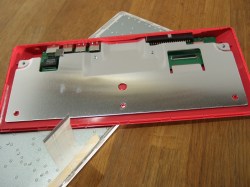
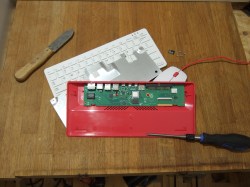
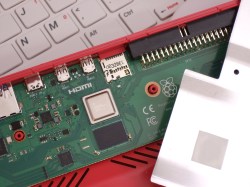
How hackable is the Pi 400? Not very. There’s not much room for any kind of foolery in here, because the heat spreader takes up most of the interior volume. Folks who want to replace the USB 3.0 with a PCIe could probably do that, of course, but they’d be better served with a compute module and some DIY. You could try to cram other stuff in here, but with the convenient 40-pin port on the back, you’ll want to connect anything of any size with a cable anyway. It’s not so much that it’s not hackable as I don’t know why you would. (As always, we’re happy to be proven wrong!)
The Whole Enchilada
There are two packages for the Raspberry Pi 400: the basic and the full kit, for $70 and $100 respectively. The extra $30 gets you a nice USB C power supply, a Raspberry mouse, a mini-HDMI to regular HDMI cable, a name-brand SD card preloaded with Raspberry Pi OS, and the Official Raspberry Pi Beginner’s Guide. In short, everything you need to get started except a monitor. All of these things are already available, but you can get them bundled in for convenience.
 The book is a nice intro that’s basically a guided tour of the great learning content already available on the Raspberry Pi website. The cable, power supply, and mouse are all good to have, and it’s certainly nice not to have to download and burn another SD card, but these are more comfort than necessity. Aside from the mini-HDMI cable, I had everything on hand anyway, though if this were a permanent installation, I would probably need to source another USB C wall wart.
The book is a nice intro that’s basically a guided tour of the great learning content already available on the Raspberry Pi website. The cable, power supply, and mouse are all good to have, and it’s certainly nice not to have to download and burn another SD card, but these are more comfort than necessity. Aside from the mini-HDMI cable, I had everything on hand anyway, though if this were a permanent installation, I would probably need to source another USB C wall wart.
I don’t know if it was just for the review model, but it was a nice touch that the SD card was already in the slot. That saved me maybe 10 seconds, but it might have confused someone who is not used to thinking of an SD card as a hard drive.
Convenience, simplicity, and ease of getting set up is exactly the name of the game here, and I think the full kit makes good on that promise. It was about as plug-and-play as possible.
Is It For You?
The Pi 400 is the least Hackaday Raspberry Pi. It’s a very slick piece of inexpensive, consumer computing for the masses. The full package is absolutely what I would give to my father-in-law. And that makes it also the first Raspberry Pi computer to really make good on the accessibility aspect of the founding dream, where they had already hammered the price. Congratulations to the Raspberry Pi folks are in order. This computer, combined with their decade-long investment in producing educational material to guide a newbie along the path, embody that dream.
This may not be the computer you want for a hacker project. That’s what the Model B is for. It’s probably not full of modification possibilities, though we’ll see what you all think. And it’s not, as far as we know, available with the full range of memory options either. If you don’t need the frills of the full package, the $70 price is a small upsell from the $55 of the equivalent Model B, but when you don’t need a keyboard or the nice case, you could put the $15 to use elsewhere.
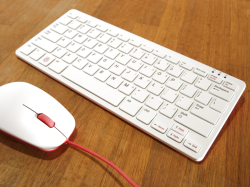
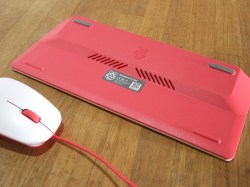
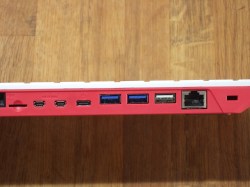
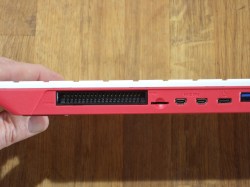
Still, combine this with a small touch screen, and run it all off of a 5 V power pack, and you’ve got a ton of portable computing in a very small package. If you’re not mousing around all the time anyway, there’s a certain streamlined simplicity here that’s mighty tempting. The 40-pin port on the back makes it easy to add your own gear too, say if you want to use it as a portable logic analyzer, microcontroller programmer, or JTAG platform. I actually prefer the horizontal orientation of this Pi port over the vertical of the Model B — my projects always end up looking like hedgehogs and gravity wants cables to lie flat. These are small details, but that’s usability.
Finally, I have a Compute Module, a Pi 4 Model B, and now the Pi 400 all sitting on the desk. The Pi 4 is known to throttle when it overheats, which conversely means that it runs faster with a heatsink, even without overclocking. There was mention in the Compute Module datasheet about more efficient processing using less power, and presumably producing less heat. And this big hunk of aluminum inside the Pi 400’s case calls out “overclocking” to me. There’s only one way to figure out what all this means, and that’s empirical testing. Stay tuned.
No comments:
Post a Comment